13 - Analysing phonetic and phonological variation on the suprasegmental level
Published online by Cambridge University Press: 05 June 2014
Summary
Introduction
This chapter describes methods of analysing phonetic and phonological variation on the suprasegmental (or prosodic) level. The suprasegmental level comprises all phonological units and processes that are larger than individual speech sounds. Thus, the prosodic features that can be investigated to document language variation and change include:
stress placement in words and utterances
speech rhythm and
intonation.
There are a number of widely accepted research methods for studying and describing phonological and phonetic variation on the suprasegmental level. In Section 2, the auditory (Section 2.1) and the acoustic method (Section 2.2) of analysing word stress are discussed. Section 3 presents methods of analysing variation in speech rhythm. The methods of studying variation in intonation are presented in Section 4. This comprises the auditory method (Section 4.1), the combined auditory-acoustic method (Section 4.2) and the acoustic analysis of pitch and intonation (Section 4.3).
Word stress
Stress is a property of syllables and refers to the relative prominence a syllable has. It is defined as an abstract phonological category that forms part of a speaker’s knowledge: it refers to the speaker’s mental representation of a property of a specific syllable of a word. While in intonation languages such as Mandarin and Igbo stress seems to play a minor role, in other languages words have specific stress patterns. In the case of fixed stress languages, all multisyllabic words of a language have stress on a particular syllable, for example on the last syllable in Turkish or on the penultimate syllable in Welsh. In languages with free lexical stress like English, all content words with two or more syllables have at least one stressed syllable. Which of the syllables is stressed can be at least in part predicted by a set of complex rules (see e.g. Roach 1991: chapters 10 and 11).
Information
- Type
- Chapter
- Information
- Research Methods in Language Variation and Change , pp. 244 - 259Publisher: Cambridge University PressPrint publication year: 2013
References
Accessibility standard: Unknown
Why this information is here
This section outlines the accessibility features of this content - including support for screen readers, full keyboard navigation and high-contrast display options. This may not be relevant for you.Accessibility Information
- 3
- Cited by
